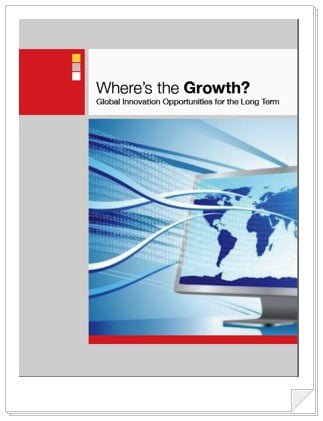 I wrote this PDF report late in 2008 after the global economic meltdown as the great 2008-09 recession was settling in.
I wrote this PDF report late in 2008 after the global economic meltdown as the great 2008-09 recession was settling in.
It was an important document then, and it is still powerful, albeit slightly dated read today.
Titled “Where’s the Growth: Global Innovation Opportunities for the Long Term“, it was a clarion call for the need for CEOs and organizations to ensure they weren’t losing sight of long-term opportunities while managing the short-term complexities of volatility from the fast-moving economic downturn.
It drew quite a bit of attention at the time and was part of what led me to provide a vast number of keynotes for associations and corporations on how to innovate through the recession. Today, I’m doing the same thing with keynotes such as 9 Things You Need to Do Right Now: Rediscovering Growth, Opportunity, and the Future When Volatility is the New Normal! [ link ] and Volatility, Uncertainty, Complexity, and Ambiguity: Leadership Strategies and Insight for the Post Pandemic World [ link ]
Mindsets at that moment in 2008 were focused on the downside of the future – as I wrote in the introduction:
“Gloom has set in on global markets. Volatility rages. Some organizations have gone into a mode of “aggressive indecision,” deferring action while they try to figure out “what comes next.” A pretty lousy strategy that is doomed to fail in the longer term.
And yet, I also wrote that real leaders were focused on a longer-term view.
Future-oriented leaders understand the reality of growth. They know that we live in a time in which opportunities for growth abound. They’ve aligned the mission of the organization so that they are capitalizing on real opportunity, not short term economic challenges.
Growth is everywhere
It’s easy during a time of economic volatility to lose sight of where the global economy is really headed. Yet while stock markets might rock, innovation thrives.
New ideas continue to be explored, markets grow, and industries emerge. A variety of trends indicate that opportunities for growth continue to surround us.”
So what happened? Shortly after that period of the gloom of ’08-09, we saw the longest running period of economic expansion in history, and those who were already preparing for it during the downturn – those who decided NOT to participate in the recession – as well as those who were prepared to think big and bold, were the winners.
With that in mind, what are you doing right now to ensure you are positioned for the inevitable economic recovery headline?
 I’m often providing detailed strategic guidance to senior executives and leaders on trends and the future, and certainly, the economy has become a big part of what I address today. Much of my time is spent putting into perspective the fact that we’ve always had downturns; there are still plenty of growth opportunities out there; innovation is even more critical now to ensure that you’re ready to go as the economy starts firing on both cylinders again (which it will.)
I’m often providing detailed strategic guidance to senior executives and leaders on trends and the future, and certainly, the economy has become a big part of what I address today. Much of my time is spent putting into perspective the fact that we’ve always had downturns; there are still plenty of growth opportunities out there; innovation is even more critical now to ensure that you’re ready to go as the economy starts firing on both cylinders again (which it will.)
What has become evident is that the most pressing issue for leaders today is a future focus. While volatility rocks global markets, there continue to be fundamental truths: your industry, products, competition, skills requirements, organizational capabilities, and ability to respond to rapid change will define your future success.
Here’s my advice on what you should be doing right now to ensure that you are ready for what comes next, based, in part, on what I was talking about in 2008.
- think growth: It’s all too easy right now to lose your enthusiasm and sense of purpose. When economies contract, so too does your motivation. Don’t let that happen — now is the worst time to lose sight of the future! Think opportunity: study my “Where’s the Growth” document, and think about what it implies

- check your speed: it’s the high-velocity economy. Markets, brands, products, industries, competition, and globalization are changing faster than ever before. Make sure you’ve got a team that can operate at the pace of change. Agility is the keyword. Search this blog for insight on that!
- immerse in ideas. The global idea cycle is collapsing. New ideas are launched, analyzed, and developed into products at a speed that is astonishing. Rapid product change is the new norm: I’m dealing with the CEO of one organization that is involved in a rapidly emerging, multi-billion dollar market that will appear, go super-nova, and disappear, over the course of about 18-24 months, before it is superseded by the next generation of product. That’s fast, and that’s a new reality.
- check your bench strength. After the cutting begins, the value goes out the door. Yet your ability to access ever more scarce, specialized skills will define your future success. It’s your ability to establish a fast, agile, quick-to-assemble collaborative team that will define your ability to grab all the opportunity that is emerging out there.
- assess your threats. where could emerging technologies, fast science, radical business models, new industry dynamics, and new regulatory macroeconomic, political, or social trends impact your bottom line in a way that you hadn’t thought of before? Two years ago, China and quality weren’t an issue.
- invest in the experience. Experiential capital — the depth of capability that you have from exploring, taking risks, and trying things out — is the financial capital. It’s a precious resource and might be in short supply if you aren’t working to build it up.
- set the tone. If you let the current economic headlines drive your corporate spirit, you’re sunk. You have to keep people focused on the future — otherwise, your team will smell your fear. Leadership is all about keeping your team focused on opportunity and goals, not on ongoing and regular (“new normal” volatility.)
As I wrote in the doocument: “Think growth. Think opportunity. Innovate for future, don’t stagnate with the past.




GET IN TOUCH
Jim's Facebook page
You'll find Jim's latest videos on Youtube
Mastodon. What's on Jim's mind? Check his feed!
LinkedIn - reach out to Jim for a professional connection!
Flickr! Get inspired! A massive archive of all of Jim's daily inspirational quotes!
Instagram - the home for Jim's motivational mind!